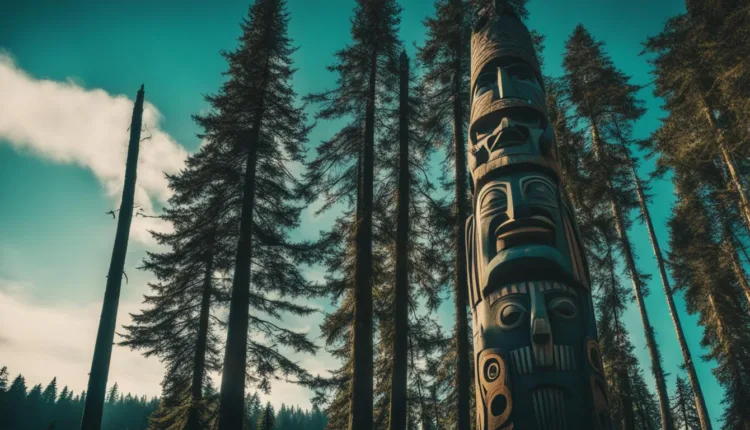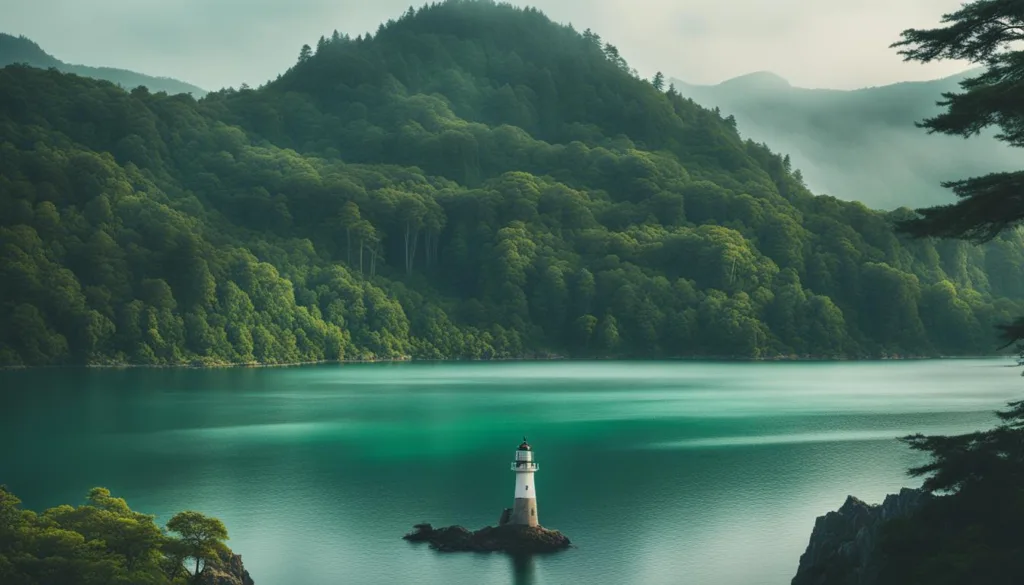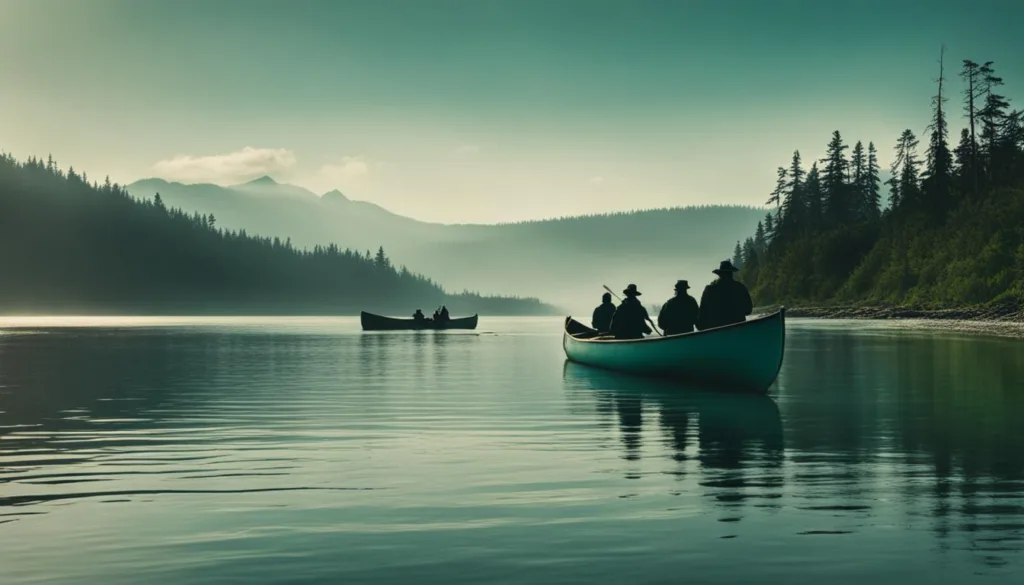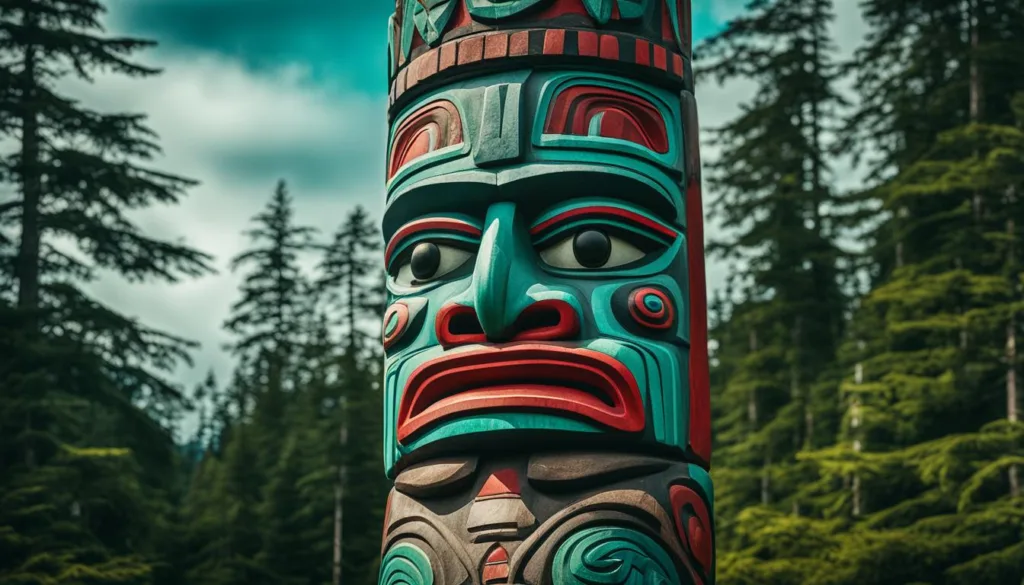Haida Gwaii (Canada): Unveiling the Mystical Charm of the North
Discovering the Enchanting Allure of Haida Gwaii, Canada

Imagine a place where mystic charm meets rich culture, stunning landscapes, unparalleled wildlife, and breathtaking national park islands surrounded by crystal-clear waters. Welcome to Haida Gwaii, a hidden gem located in the North of Canada. This archipelago, consisting of islands off the mainland, is home to Naikoon Provincial Park. This mystical destination, also known as the Queen Charlotte Islands, is an archipelago paradise waiting to be explored. Located off the mainland, this park is a must-visit for nature enthusiasts. Don’t miss the chance to discover the stunning beauty of George Park.
Haida Gwaii, an archipelago of islands, boasts a fascinating Haida culture deeply rooted in its history. The population on the mainland is captivated by this rich heritage. From intricate wood carvings and totem poles on the islands to immersive Indigenous tourism experiences on the mainland, you’ll have the chance to discover the rich heritage of the Haida people firsthand. Explore the nation’s cultural treasures and find valuable information about their traditions and customs. Step into the past as you explore ancient Haida villages on the islands and learn about their captivating history on the mainland. George was a significant part of this captivating history.
But Haida Gwaii, also known as the islands of George, isn’t just about culture – it’s a natural wonderland too. With its breathtaking landscapes, including islands and dense rainforests, this Pacific Northwest gem will leave you in awe. The rugged coastlines add to the beauty of this place. Don’t miss out on exploring the islands and experiencing their unique charm. Wildlife enthusiasts will have the opportunity to spot bald eagles, black bears, whales, and sea lions in their natural habitat on the islands. These islands are known for their diverse wildlife and are a haven for nature lovers. Outdoor adventurers will find endless opportunities for hiking, kayaking, and immersing themselves in the pristine wilderness of the islands. The name of these islands is yet to be disclosed.
As you delve deeper into Haida Gwaii islands, you’ll uncover the secrets of Haida art. Renowned for its intricate designs and storytelling, Haida art reflects the cultural significance of the islands in this vibrant community. Traditional art forms passed down through generations on the islands, such as Haida art, as well as contemporary works by local artists, showcase the ongoing vitality and evolution of art.
Take a journey through time as you explore Haida villages and historical sites on the islands. These ancient islands remnants offer a glimpse into the vibrant past of the Haida people, with fascinating artifacts and archaeological discoveries unfolding the stories of generations past on the islands.
While the history of Haida Gwaii islands has faced challenges, including the tragic consequences of settler contact and resource mismanagement, the Haida community continues to preserve their traditions and embrace conservation and sustainability on the islands. Their traditional resource management practices rooted in care, respect, and wise use serve as a reminder of the importance of preserving our islands and environment.
Preserving Haida knowledge and worldviews on islands is paramount, and Indigenous scholars have played a vital role in this mission. Through their teachings and stories, the interconnectedness of all living beings on islands and the importance of stewardship for islands are shared with the wider world.
Art enthusiasts will be captivated by the visual art of Haida Gwaii, a group of islands known for its stunning artistic creations. From traditional carvings to contemporary pieces, the cultural expression and identity of the Haida people on the islands shine through their artwork, resonating with audiences near and far.
So, why wait? Embrace the mystic charm of Haida Gwaii islands and embark on an unforgettable journey filled with rich culture, stunning landscapes, and unparalleled wildlife. Get ready to discover the hidden treasures of the North islands.
Key Takeaways:
-
Haida Gwaii is a mystical destination in the North of Canada known for its rich culture, stunning landscapes, unparalleled wildlife, and breathtaking islands.
-
Explore the fascinating Haida culture and heritage on the islands through intricate art, ancient villages, and immersive Indigenous tourism experiences.
-
Discover the natural wonders of Haida Gwaii, a group of islands, from dense rainforests to rugged coastlines, and spot diverse wildlife such as bald eagles, black bears, whales, and sea lions.
-
Uncover the secrets of Haida art, from traditional forms passed down through generations to contemporary works by local artists on the islands.
-
Experience the vibrant past of the Haida people by exploring ancient villages and historical sites on the islands that reveal fascinating artifacts and archaeological discoveries.
Discovering Haida Culture and Heritage
The Haida Gwaii islands archipelago is a treasure trove of Haida culture and heritage. The Haida people, known for their rich artistic tradition, have created intricate wood carvings, totem poles, and stunning artwork on the islands for centuries. These island masterpieces not only showcase their incredible craftsmanship but also embody the spiritual and cultural significance of the Haida people.
Haida Gwaii, also known as the islands, is home to ancient Haida villages that provide a glimpse into the past. These villages, located on the islands of Skidegate and Old Massett, are living museums preserving the customs and traditions of the Haida people. Visitors can explore longhouses on the islands, listen to stories passed down through generations, and witness traditional ceremonies that have been practiced for thousands of years.
“Our art is not just about aesthetics, it tells our stories, connects us to our ancestors, and reaffirms our identity as Haida people.” – Chief Councillor Kung Haida
Indigenous tourism initiatives on the islands offer immersive experiences for visitors to learn about the Haida way of life. Through guided tours and cultural programs, participants can engage with Haida elders on the islands, learn traditional crafts specific to the islands, and gain a deeper understanding of the cultural significance of Haida art on the islands. This interaction fosters mutual respect and appreciation, ensuring the preservation and promotion of Haida culture for future generations on the islands.
| Haida Village | Location | Description |
|---|---|---|
| Skidegate | Southwest coast of Graham Island | A vibrant community with a rich history and a thriving art scene, the islands are a must-visit destination for those seeking beauty and inspiration. |
| Old Massett | Northwest coast of Graham Island | A traditional village renowned for its totem poles, cultural events, and stunning islands. |
| Kay Llnagaay | Skidegate | A museum on the islands that houses a remarkable collection of Haida artifacts and artworks. |
Experience the Spirit of Haida Gwaii
As you immerse yourself in the enchanting world of Haida Gwaii islands, you will discover that Haida culture is not just a static reflection of the past but a living, breathing entity that continues to evolve. Contemporary Haida artists, such as Robert Davidson and Jaalen Edenshaw, draw inspiration from their cultural heritage while pushing the boundaries of traditional art forms on the islands.
By exploring Haida culture and heritage on the islands, visitors gain a profound appreciation for the resilience and creativity of the Haida people. The journey deepens our understanding of the islands’ worldviews, their connection to the land and sea, and their unwavering commitment to preserving their cultural identity in the face of tremendous challenges.
Next, we will delve into the natural wonders of Haida Gwaii, where breathtaking landscapes and unparalleled wildlife await.
Experiencing the Natural Wonders of Haida Gwaii
Haida Gwaii, located in the Pacific Northwest of British Columbia, is a destination that boasts stunning landscapes and an abundance of wildlife. From dense rainforests to rugged coastlines, the natural wonders of Haida Gwaii offer a paradise for nature enthusiasts.
Exploring the pristine wilderness of Haida Gwaii allows visitors to immerse themselves in the breathtaking beauty of the Pacific Northwest. Hiking trails wind through ancient forests, offering glimpses of towering cedar and spruce trees. As you walk, you may encounter diverse wildlife, such as bald eagles soaring through the sky or black bears foraging for food.
“Haida Gwaii captivates visitors with its mystic charm, rich Haida culture, stunning landscapes, and unparalleled wildlife.“
For those who prefer to explore the water, kayaking along Haida Gwaii’s coastlines reveals hidden coves, sea caves, and rocky shores. Keep an eye out for pods of orcas swimming gracefully in the ocean or sea lions basking in the sun on distant rocks.
Ultimately, Haida Gwaii’s natural wonders provide endless opportunities for adventure and discovery. Whether you choose to hike, kayak, or simply immerse yourself in the tranquility of the surroundings, this enchanting destination will leave you in awe of its stunning landscapes and abundant wildlife.

Example: Wildlife Spotting in Haida Gwaii
| Wildlife | Best Time to Spot |
|---|---|
| Bald Eagles | All year round |
| Black Bears | Spring and fall |
| Orcas | Summer months |
| Sea Lions | All year round |
Table: Wildlife spotting opportunities in Haida Gwaii
Uncovering the Secrets of Haida Art
Haida art is a treasured and culturally significant form of artistic expression that has captivated audiences for centuries. Rooted in tradition and infused with contemporary influences, Haida art showcases the rich cultural heritage of the Haida people. From intricate carvings to vibrant paintings, the artistry of the Haida is a testament to their deep connection with the natural world and their ancestral roots.
Traditional art forms play a vital role in Haida culture, representing a visual language that communicates stories, legends, and spiritual beliefs. Carved totem poles, adorned with intricate designs and symbols, serve as monumental expressions of Haida identity and ancestry. Each totem pole tells a unique story, tracing the lineage and history of the Haida people.
In recent years, a new generation of Haida artists has emerged, blending traditional techniques with contemporary influences to create captivating and thought-provoking pieces. These contemporary artists push the boundaries of Haida art, exploring themes of cultural resurgence, environmental conservation, and social commentary. Their artwork serves as a bridge between the past and the present, preserving the cultural heritage of the Haida while reflecting the realities of the modern world.
“Haida art is not just about aesthetics; it’s about preserving our culture, reclaiming our identity, and sharing our stories with the world,” says Haida artist and activist, Robert Davidson.
The cultural significance of Haida art cannot be overstated. It is a powerful medium for storytelling, a form of resistance against cultural assimilation, and a means to create dialogue and understanding between Indigenous and non-Indigenous communities. Through their art, Haida artists continue to carry forward the legacy of their ancestors, ensuring that their traditions, stories, and worldviews remain alive and vibrant today.
| Haida Art Forms | Cultural Significance |
|---|---|
| Carved Totem Poles | Monumental expressions of Haida identity and ancestral stories. |
| Weaving | Intricate baskets and textiles that showcase Haida craftsmanship and design. |
| Painting | Vibrant and symbolic artwork that conveys Haida stories and spiritual beliefs. |
| Jewelry | Adornments that reflect Haida motifs and cultural significance. |
Exploring Haida Villages and Historical Sites
Haida Gwaii is a treasure trove of ancient history and cultural heritage, with its numerous Haida villages and historical sites offering a window into the past. These sites provide a fascinating glimpse into the rich traditions and customs of the Haida people, capturing the essence of their vibrant and resilient culture.
One such notable village is Skedans, located on Haida Gwaii’s northern coast. Skedans is an archaeological site that showcases the remains of longhouses, totem poles, and other structures that were integral to Haida life. Exploring this village allows visitors to witness the architectural prowess of the Haida people and gain a deeper understanding of their communal way of life.
“The ancient artifacts found in these villages offer invaluable insights into the history and cultural practices of the Haida people.”
| Haida Village | Location | Significance |
|---|---|---|
| Skedans | North coast of Haida Gwaii | Archaeological site showcasing remains of longhouses and totem poles |
| Kay Llnagaay | Sandspit, Haida Gwaii | Cultural center with exhibits on Haida history and art |
| Masset | Graham Island, Haida Gwaii | The largest Haida village with rich cultural significance |
Another must-visit site is Kay Llnagaay, located in the community of Sandspit. This cultural center is dedicated to preserving and showcasing Haida history and art. Visitors can explore exhibits that delve into the region’s rich cultural heritage, including displays of traditional Haida regalia, sculptures, and contemporary artwork.
Lastly, the village of Masset on Graham Island is not to be missed. As the largest Haida village, Masset holds immense cultural significance. It offers a glimpse into the Haida way of life through its museums, art galleries, and community events that celebrate Haida traditions.
Whether you’re exploring Skedans, Kay Llnagaay, Masset, or any other Haida village, the ancient artifacts found in these villages offer invaluable insights into the history and cultural practices of the Haida people. These sites serve as a reminder of the enduring legacy of the Haida and their contributions to the cultural tapestry of Haida Gwaii.

References:
-
Link 1
-
Link 2
-
Link 3
Understanding the Impact of Settler Contact
The arrival of European settlers in Haida Gwaii had tragic consequences for the Haida people. With white settler contact came the introduction of new diseases, such as smallpox, which devastated the Haida population. The loss of lives was substantial, leading to a significant decline in the Haida community. Alongside the devastating impact on the population, settler contact also brought about cultural disruption and a sense of displacement for the Haida people.
The exploitation of resources by European settlers further compounded the challenges faced by the Haida community. The rich natural resources of Haida Gwaii, including timber, fish, and minerals, were extensively exploited without considering the long-term consequences. Resource mismanagement since the 1800s has resulted in significant environmental degradation, threatening the delicate balance of the ecosystems on the islands and further undermining the traditional way of life of the Haida people.
These tragic consequences and the ongoing challenges faced by the Haida community serve as a stark reminder of the importance of recognizing and addressing the impacts of settler contact. It is crucial to acknowledge the historical injustices and work towards reconciliation and sustainable practices that respect the land, culture, and rights of the Haida people. By understanding this history and its consequences, we can strive for a more inclusive and equitable future for all.

The Tragic Consequences of Settler Contact
“The arrival of European settlers in Haida Gwaii was a turning point in our history, bringing immense tragedy and challenges,” says Elder Elizabeth White. “The introduction of diseases and the relentless exploitation of resources disrupted our way of life and had far-reaching consequences for our people.”
“We must acknowledge the past and the impact of settler contact if we are to move forward towards a more inclusive and sustainable future,” emphasizes Chief Robert Davidson. “The Haida people have always been stewards of the land and have valuable knowledge to contribute in the face of ongoing environmental challenges. It is through collaboration and acknowledgement of our shared history that we can work towards a better future.”
Recognizing the Importance of Conservation and Sustainability
The Haida people have long understood the significance of conservation and sustainability in preserving their culture and environment. Traditional resource management practices, rooted in wise use, care, and respect for the land, have allowed the Haida to maintain a harmonious relationship with their surroundings.
Central to their approach is the concept of wise use, which emphasizes using resources in a way that ensures their long-term availability and takes into account the needs of future generations. The Haida people have a deep understanding of the interconnectedness of all living beings and recognize that the well-being of the land and its inhabitants is vital for their own survival.
“We have always known that our well-being is tied to the health of the land and the sea. Our ancestors taught us the importance of caring for our environment and preserving our cultural traditions. It is our responsibility to continue their legacy and protect the natural wonders of Haida Gwaii.”
– Elder Gwaiin Kuns
Conservation efforts are evident in various aspects of Haida life, from sustainable fishing practices to the protection of sacred sites. The Haida Gwaii Watchmen, a group of caretakers appointed by the Haida Nation, play a crucial role in safeguarding cultural and ecological sites. Their presence ensures that these areas are respected and visited responsibly, minimizing the impact of tourism on the delicate ecosystems.
By embracing conservation and sustainability, the Haida people are not only preserving their cultural heritage but also setting an example for other communities around the world. Their practices serve as a reminder of the importance of harmonious coexistence with nature and the need to protect our planet for future generations.
Traditional Resource Management Practices
The Haida people have developed a comprehensive system of traditional resource management that encompasses various aspects of their daily lives. This system includes:
-
Seasonal harvesting practices that allow for the sustainable use of resources
-
Community-based decision-making processes that ensure the equitable distribution of resources
-
Traditional ecological knowledge passed down through generations, guiding resource management practices
These practices continue to be an integral part of Haida culture and play a crucial role in maintaining the ecological balance of Haida Gwaii.
| Traditional Resource Management Practices | Conservation Initiatives |
|---|---|
| Seasonal harvesting practices | Establishment of protected areas to preserve biodiversity |
| Community-based decision-making processes | Implementation of sustainable fishing practices |
| Traditional ecological knowledge | Conservation education programs |
Preserving Haida Knowledge and Worldviews
Preserving Haida knowledge and worldviews is crucial to understanding the rich cultural heritage of Haida Gwaii. The teachings, stories, and traditions passed down through generations provide valuable insights into the interconnectedness of all living beings and the Haida people’s deep connection with their environment. Indigenous scholars have played a significant role in preserving and sharing this knowledge with the wider world, ensuring that it continues to thrive.
Indigenous Scholars
“The wisdom of our ancestors is embedded in our teachings and worldviews. It is our responsibility as Indigenous scholars to carry forward this knowledge and ensure its preservation for future generations.” – Earl Maquinna George
Earl Maquinna George, an influential Indigenous scholar, has dedicated his life to studying and safeguarding Haida cultural practices. His work has shed light on the importance of Haida knowledge in shaping sustainable resource management practices and promoting environmental stewardship. Through his research and advocacy, George has played a crucial role in raising awareness about the significance of Haida worldviews and their relevance in the modern world.
Guujaw, another prominent Indigenous scholar, has also contributed immensely to preserving and promoting Haida knowledge. As a former President of the Haida Nation, Guujaw has championed Haida rights and advocated for sustainable development that aligns with Haida values and worldviews. His efforts have helped bridge the gap between traditional knowledge and contemporary issues, fostering a greater understanding and appreciation for Haida cultural heritage.
Teachings and Stories
The teachings and stories passed down by Haida elders encapsulate a wealth of wisdom and knowledge. They provide guidance on sustainable living, resource management, and the preservation of cultural practices. These teachings emphasize the importance of caring for the land, respecting nature, and maintaining harmony with the environment. They serve as a reminder of the enduring values and worldviews that continue to shape Haida Gwaii today.
By preserving Haida knowledge and worldviews, we can gain a deeper appreciation for the cultural significance and wisdom embedded within their teachings. It is through the efforts of Indigenous scholars like Earl Maquinna George and Guujaw that Haida cultural heritage continues to thrive, inspiring future generations to connect with their roots and embrace the profound teachings and worldviews of the Haida people.
Celebrating the Visual Art of Haida Gwaii
The visual art of Haida Gwaii is a testament to the rich cultural expression of the Haida people. Both traditional and contemporary art forms showcase the creativity and skill of Indigenous artists, weaving together stories of the past and present. From intricately carved totem poles to vibrant paintings and sculptures, the art of Haida Gwaii captivates with its beauty and symbolism.

Traditional art holds a special place in Haida culture, with techniques and designs passed down through generations. Carved totem poles, often towering over 40 feet tall, are a prominent feature of Haida Gwaii’s artistic landscape. Each pole tells a unique story, representing important mythological figures or serving as a memorial to ancestors. These majestic creations stand as a testament to the enduring cultural legacy of the Haida people.
Contemporary art has also flourished in Haida Gwaii, with Indigenous artists finding new ways to express their cultural identity. Through their work, they explore themes of cultural resurgence, identity, and community. Paintings that blend traditional motifs with modern techniques offer a fresh perspective on Haida culture, while sculptures and installations provide thought-provoking commentary on social and environmental issues.
Table: A Comparison of Traditional and Contemporary Haida Art
| Traditional Haida Art | Contemporary Haida Art |
|---|---|
| Carved totem poles | Mixed media installations |
| Woven baskets | Sculptures made from recycled materials |
| Potlatch regalia | Paintings blending traditional and modern techniques |
The art of Haida Gwaii is not only a form of cultural expression but also a means of preserving and sharing Haida knowledge. It serves as a visual representation of their worldview, connecting past, present, and future generations. Through their art, Indigenous artists continue to inspire and educate, creating a bridge between cultures and fostering a deeper appreciation for Haida heritage.
Read More: Capri Island (Italy): Unveiling the Mediterranean’s Hidden Gem
Conclusions: Embracing the Mystical Charm of Haida Gwaii
As I conclude my journey through Haida Gwaii, I am left in awe of its mystic charm, rich culture, stunning landscapes, and unparalleled wildlife. This captivating destination has truly captured my heart and soul. From immersing myself in the vibrant Haida culture to exploring the breathtaking wilderness, every moment on this enchanting archipelago has been filled with wonder and discovery.
Haida Gwaii holds a profound sense of authenticity, where the traditions and teachings of the Haida people are woven into the fabric of everyday life. The artistry displayed in their intricate carvings and the stories told through their totem poles speak volumes about their deep connection to the land and their ancestral roots. It is a testament to their resilience and the preservation of their cultural heritage.
But it’s not just the rich culture that makes Haida Gwaii extraordinary. The landscapes are nothing short of breathtaking. From the dense rainforests to the rugged coastlines, the natural beauty of this place is awe-inspiring. As I hiked through the trails, I was surrounded by an abundance of wildlife, from majestic bald eagles soaring above to playful sea lions basking in the sun. It is a paradise for nature enthusiasts and a reminder of the importance of conservation in preserving such pristine ecosystems.
My time in Haida Gwaii has been a journey of discovery, connecting me to a world filled with magic, history, and natural wonders. It is a place that invites you to embrace the mystic charm that lingers in the air, to immerse yourself in a rich and vibrant culture, and to be amazed by the stunning landscapes and unparalleled wildlife. Haida Gwaii is a treasure that should be cherished and protected, ensuring its beauty and cultural heritage endure for generations to come.
FAQ
What is Haida Gwaii?
Haida Gwaii, also known as the Queen Charlotte Islands, is a mystical destination located in the Pacific Northwest of Canada.
What is Haida culture known for?
Haida culture is known for its unique artistic tradition, including intricate wood carvings, totem poles, and stunning artwork.
Are there opportunities for outdoor activities in Haida Gwaii?
Yes, Haida Gwaii offers opportunities for hiking, kayaking, and wildlife spotting in its stunning landscapes.
What can I learn about at Haida villages and historical sites?
Visitors can explore the remains of longhouses, view ancient artifacts, and learn about archaeological discoveries that shed light on Haida history.
What impact did European settlers have on Haida Gwaii?
The arrival of European settlers had tragic consequences for the Haida people, including a decline in population and cultural disruption.
How have the Haida people practiced traditional resource management?
The Haida people have long practiced traditional resource management techniques rooted in conservation, sustainability, and respect for the land.
What is the significance of Haida art?
Haida art is culturally significant and notable for its intricate designs, storytelling, and representation of Haida traditions and identity.
How can I experience Haida Gwaii’s mystic charm?
Exploring Haida Gwaii allows for a deeper understanding of Haida culture and the importance of preserving their heritage.
Can contemporary artists be found in Haida Gwaii?
Yes, Haida Gwaii is home to contemporary Indigenous artists who use traditional techniques to create unique and modern pieces.
What makes Haida Gwaii a unique travel destination?
Haida Gwaii offers a combination of rich Haida culture, stunning landscapes, and unparalleled wildlife, making it a captivating and unforgettable experience.


